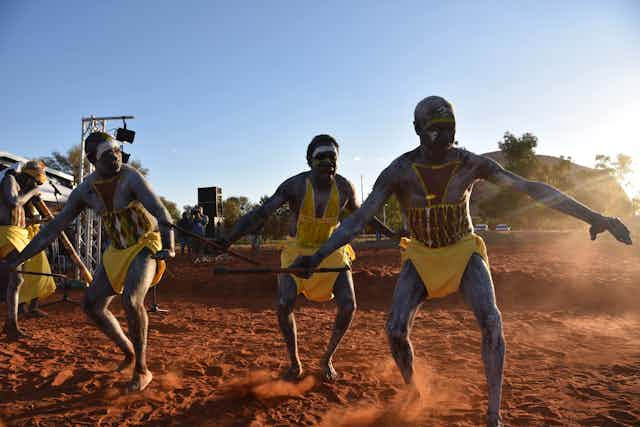My research on South Africa’s race politics yielded a startling metaphor. In 1936, the government established the 60-member Natives’ Representative Council as part-compensation for the abolition of the Cape Province’s black franchise. By 1947 it refused to continue. As councillor Paul Mosaka explained:
We have been fooled. We have been asked to co-operate with a toy telephone. We have been speaking into an apparatus which cannot transmit sound and at the end of which there is nobody to receive the message. Like children, we have taken pleasure at the echo of our own voices …
Apart from white disdain for the council, and for similar bodies established elsewhere to hear black voices, the problem endures: they advise, but are rarely – if ever – heard.
Today, in Australia, the Referendum Council contends there should be a place for Indigenous voices in the Constitution. A mechanism to do so is awaited.
Further reading: Response to Referendum Council report suggests a narrow path forward on Indigenous constitutional reform
Australia has previously flirted with designated parliamentary seats for Aborigines elected on an Aboriginal roll, akin to the (now) seven reserved seats for Māori in New Zealand. In 1944 Pastor Doug Nicholls sought one such federal seat for an Aborigine but “if that be too much, then a white man of our choosing”.
But no-one seems to remember, or cares to remember, two relatively recent structures that ended dismally – the National Aboriginal Consultative Committee (1972 to 1977) and the Aboriginal and Torres Strait Islander Commission (1990 to 2005) – and use the lessons from these experiences to inform current debates.
The National Aboriginal Consultative Committee experience
In December 1973, 41 Aborigines were elected on a separate roll to sit on the National Aboriginal Consultative Committee, a body that Aboriginal Affairs Minister Gordon Bryant said was to “advise” him “on matters pertinent to Aboriginal citizens”.
On polling day, Prime Minister Gough Whitlam told the committee that:
Our most important objective now is to restore to Aborigines the power to make decisions about their own way of life.
That looked and sounded promising. But when Senator Jim Cavanagh replaced Bryant as minister, he quickly declaimed:
If your proposals are wise and logical, the government would reject them only at its own peril.
Cavanagh went on to define the committee as a forum for Aboriginal expression.
Deluded, by February 1974 the committee voted to become the National Aboriginal Congress, possibly with some of the connotations that the word “congress” had in African colonisation politics. Its aim was to have the Department of Aboriginal Affairs act as its secretariat.
But their power, Cavanagh ruled, “is only to advise”, and he decided not to pay the members’ salaries if they thought otherwise. The compromise was a new constitution for a National Aboriginal Conference, but still an advisory body.
Wrangling continued about the conference’s constitution. And when Liberal Ian Viner became the minister in 1976 he instituted an inquiry into the conference, chaired by anthropologist Lester Hiatt.
Despite reforms, the whole concept proved ineffective and inept. Servicing by the Department of Aboriginal Affairs was half-hearted, the large electorate was unwieldy, meetings were desultory and – significantly – its resolutions were ignored.
Lessons from ATSIC
In March 1990, Labor legislated for a 20-member Aboriginal and Torres Strait Islander Commission (ATSIC). It was to have an appointed chair (Lowitja O’Donoghue initially), two appointed members and 17 elected commissioners. Seventeen zones (of tribal/land affiliation) were divided into 60 regional councils, with 30 regional offices.
The Coalition saw ATSIC “as a way forward”. In many ways it was. It catered to the reality that Aborigines and islanders are not “one people” with a common history, or a common past or present.
By 1993 ATSIC had a budget of A$800 million. It had wide-ranging programs, including oversight of the Royal Commission into Aboriginal Deaths in Custody’s recommendations, and finding ways for local people to participate in health promotion.
Despite some nightmare scenarios of nepotism, poor accounting procedures and staffing difficulties, ATSIC gave Aborigines political participation, a voice independent of government, culturally appropriate programs, an avenue to state and territory co-operation, and a distinct voice for Torres Strait Islanders.
But, by 2005, the Coalition government said “enough”. The government abolished the commission and replaced it in 2007 with a Mal Brough-designed “Intervention”. This signalled that only he knew what was in their best interests – Aboriginal voices were of no matter or moment.
Remote Aboriginal communities were to be quarantined yet again, as they were in 1896 and beyond, but this time to protect them not from predators who wanted to kill them or take their women and children, but to save them from themselves.
Nearly a century of resistance, resilience, self-help, economic enterprise, educational, artistic and sporting advancement was to be wiped in a moment.
What about the future?
What new administrative creature lurches toward Canberra in 2018 or 2019?
If it is to have no executive, political and financial authority, and if its decisions have always to be “wise” and “logical” in governmental eyes, then we are in for another expensive and doomed instrument.

